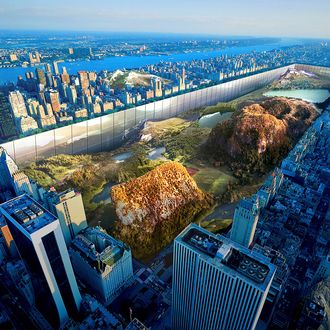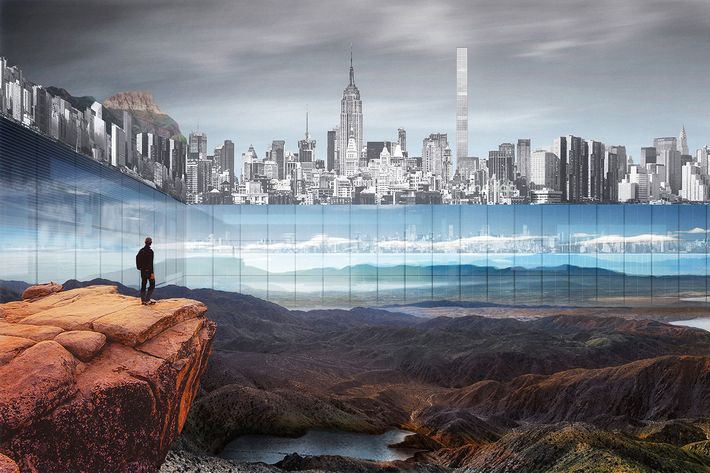
Two young architects have won the web magazine eVolo’s annual design competition with this grand proposal: Dig out Central Park, drop it nearly a quarter-mile, and line the sides of the pit with a mirror-faced apartment slab that burrows 100 feet horizontally under the surrounding cityscape.
Why do such a thing? It’d add tens of thousands of apartments with park views! Affordable housing! Democratization! And after all, there’s a long history of thought experiments about alternative uses for Central Park, including having it appraised, as New York did, jokingly, in 2005. That figure is probably up a good 40 percent by now.
This proposal is no doubt meant to be cheeky — but also presumably half-plausible and worthy of discussion. So let’s explore just how terrible the idea really is.

Never mind, at first, the physical city that actually exists. That, for example, several subway lines run under Central Park. That our water-supply tunnels do as well. That the very nice buildings lining the current park, their foundations newly undermined, will want to collapse into the new park. That this giant pit will turn into a bathtub when it rains, or in fact when it doesn’t rain. (Remember that the MTA, with subway lines perhaps 30 feet below the surface, pumps groundwater out of them constantly.) That deep holes tend to collect trash as well as water. Plus, whatever unfathomably foul urban stuff sluices down the glass: Imagine life on the first floor of that thing. And consider, if you will, how dark it is at 3 p.m. on a December day in New York. Now consider it from the bottom of a quarter-mile-deep hole.
These two architects — both recent graduates of the Rhode Island School of Design — apparently didn’t worry much about preserving the signature quality of Central Park that makes it successful: its porosity at the edges, and its enveloping nature once you’re inside. It costs nothing — and not only in terms of money — to enter or exit. You can drift in and out, from cityscape to greenery and back, almost without meaning to. Yet you wander in just a couple of hundred feet, and unless you crane your neck to look at the San Remo, you almost can’t tell you’re in the Manhattan grid. Needless to say, that will not be true if you’re a hundred stories down. Ample evidence exists that when buildings put sunken plazas out front — merely 15 feet or so below the sidewalk — they go un-strolled. The General Motors building had one, and it played host to failed tenant after failed tenant. It has only scored today because the Apple Store paved it over and brought the entrance up to grade.
But, the urban historians among you may be thinking, Central Park is not natural landscape! That is true. When Frederick Law Olmsted and Calvert Vaux designed it, it was basically a big field containing a few trees and rocks. Virtually everything you see today, from the Reservoir to the Ramble, was built from scratch. So basically we’d be demolishing it and attempting to reconstruct it from the get-go. But it is worth keeping in mind that it took us 150 years to get mature trees, and we have just spent decades lovingly repairing places like Belvedere Castle, which would be discarded.
The designers’ argument hinges upon a well-intentioned, vaguely de Blasio–ish impulse: This would provide thousands of apartments on an otherwise tapped-out, overpriced island, and we can make them affordable. Never mind that clustering such housing in big hives has, as a theory, been widely discredited; the only thing that might work less well than a clump of poorly maintained housing-project towers would be a clump of poorly maintained housing-project towers whose floors are buried in the earth and have windows on only one side. You’d basically be creating the inverse version of Kowloon Walled City, arguably the most nightmarish place in the history of urban life. I’d also enjoy seeing how the residents of every Fifth Avenue and Central Park West co-op react to ceding their front yards to a black hole.
Still, there has been a worse idea for Central Park. In 2009, the Manhattan Airport Foundation suggested converting that long green “undeveloped area between 59th and 110th Streets” into an airfield. Those folks, mercifully, were kidding.






























